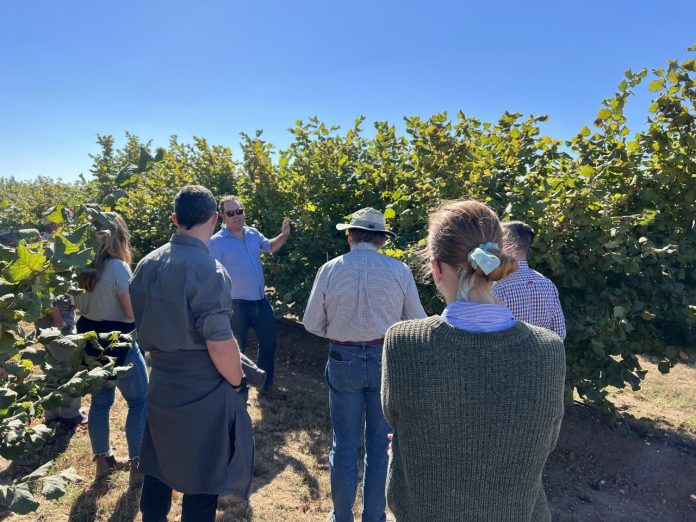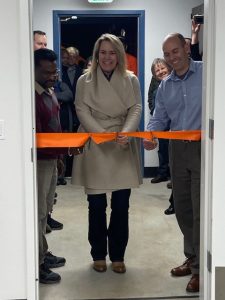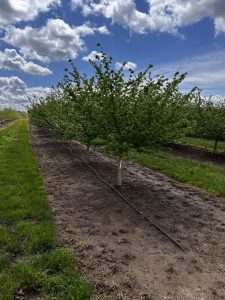
The renovation of two research laboratories and construction of three new labs at North Willamette Research and Extension Center (NWREC) in Aurora, Ore. is expected to enhance research capabilities for Nik Wiman, Oregon State University Extension orchard specialist, particularly when it comes to insect management in hazelnuts.
“That will give him more space to accommodate insect rearing and other research activities,” said Surendra Dara, director of the station. “Nik’s current space is very tiny.”
The new labs, one dedicated to soils and chemistry and one to plants and a molecular lab, are housed at the Parker House, a farmhouse adjacent to the main office at NWREC. The labs were inaugurated in December and were expected to open in January or February.
Construction crews were expected to start renovating the station’s old labs, which are located in the basement of the main building, after researchers moved into the new labs. Once the renovation is complete, Wiman will have space in both sets of the shared labs.
The construction of the new labs was made possible by a donation of $250,000 from Northwest Farm Credit Services and from $425,000 of capital improvement funds provided by the university’s College of Agricultural Sciences.
The renovation of the old lab is being funded by a $500,000 donation from local farmers Carl and Kim Casale. Carl Casale, a former president and CEO of CHS, currently serves as a senior partner at Ospraie Management LLC, a New York investment firm. The Casales own and manage a family farm near the Aurora station.
The Casale donation was the largest ever private donation for the station, according to former station director Mike Bondi, who retired in 2021.
Developments to improve the station’s facilities were jumpstarted when Bondi submitted a proposal to the OSU College of Agricultural Sciences to utilize a state fund dedicated to capital improvements at off-campus facilities that was created in 2019. The initial capital improvement funding, which came later that year, supported two projects: a new well for the farm and the Parker Lab construction.
“The Parker Lab project received the maximum award from the college [for that funding source] of $425,000,” Bondi said.

Dedicated Fund
Bondi added that the funding source was created by the 2019 Oregon Legislature, which dedicated about $2 million in state funding each biennium for 10 years specifically for improvements at off-campus facilities.
“We had never seen this kind of funding in the past, and it has been really appreciated with so many of our off-campus facilities needing updating,” Bondi said.
Still, the project budget for Parker House exceeded the College of Agricultural Sciences funding, Bondi said. Northwest Farm Credit Services came up with the additional funds.
“The College of Agricultural Sciences has been supported by Northwest Farm Credit Services for years, where they pick several programs to direct their funding,” Bondi said. “I believe our Northwest Farm Credit Services Advisory Council members, who were knowledgeable about our lab remodel project and knew we needed additional funding to complete it the way we wanted and needed to, put in a good word for us with NWFCS as they prioritized their $1.5 million gift in 2020.”
In the latter part of 2020, Bondi then met with Carl and Kim Casale, who, according to Bondi, were looking for projects to support with their personal philanthropy.
“I met with them and toured our facilities and shared the big plans to remodel Parker,” Bondi said. “Planning was well underway, and the initial demo was in process. Carl and Kim saw a lot going on, other commitments being made, upgrades and improvements already in motion and decided their funding could continue to build on our momentum.”
Their funding was committed in spring 2021, Bondi said.
“This has been a nice addition,” Dara said. “Space is the big need for everybody here, whether it is office space, lab or greenhouse space, and these funds and donations are really helping us to get these needs addressed.”
NWREC, a 160-acre facility located about 25 miles south of Portland, is OSU’s only agriculture field research station in the Northwest part of the state. It serves farmers in a seven-county area focusing on cropping systems common in the Willamette Valley, including nursery crops, fresh vegetables, specialty seed crops, berries and orchard crops including hazelnuts.
NWREC also is the location of the state’s only IR-4 Pesticide Registration program, which works to obtain pesticide registration for minor crops including hazelnuts.

Six-Acre Orchard
Wiman has planted a six-acre hazelnut orchard with the varieties Jefferson, McDonald, Yamhill and Wepster.
Among other projects, Wiman is working on horticultural practices, irrigation and nutrient management as well as control tactics for diseases and insects.
One of seven faculty members leading researcher programs at the site, Wiman has two assistants, a graduate student and multiple undergraduate assistants working under him.
He, along with seven other OSU researchers, published a paper online this past fall outlining the economic impacts of hazelnut pests and their management, a report that showed a 43% difference between the maximum attainable yield and the actual yield of hazelnuts. About half of the difference was attributed to pest damage, according to the report. The findings were based on responses to a survey distributed to hazelnut producers.
The survey is helping researchers determine priorities, according to the report, and, according to Dara, highlights the need for continuing hazelnut research.
Respondents reported diseases as having the largest negative impact on hazelnut yield at around 6.1% of yield loss per acre. Invertebrates were the next largest negative impact with an estimated 5.8% yield loss effect per acre.
Eastern filbert blight, aphids and filbertworm were the dominate species causing negative yield impacts, according to the report. Those three accounted for close to 10% yield loss on average.
Since the survey, brown marmorated stink bug has emerged as a significant pest in hazelnuts as well, and Wiman is working to help growers control it through chemical and non-chemical approaches, including use of an egg parasite, Trissolcus japonicus, known commonly as the samurai wasp.
Native to China, Japan and Korea, which is the same native range of the brown marmorated stink bug, the samurai wasp was accidentally introduced in the western U.S. and first recorded in Vancouver, Wash. in 2015.
The wasp parasitizes the eggs of brown marmorated stink bug, and adult wasps emerge from eggs by chewing their way out.
Wiman has asked growers to inform researchers if they see evidence of parasitized egg masses. Go to agsci.oregonstate.edu/bmsb for information on how to report a finding.










